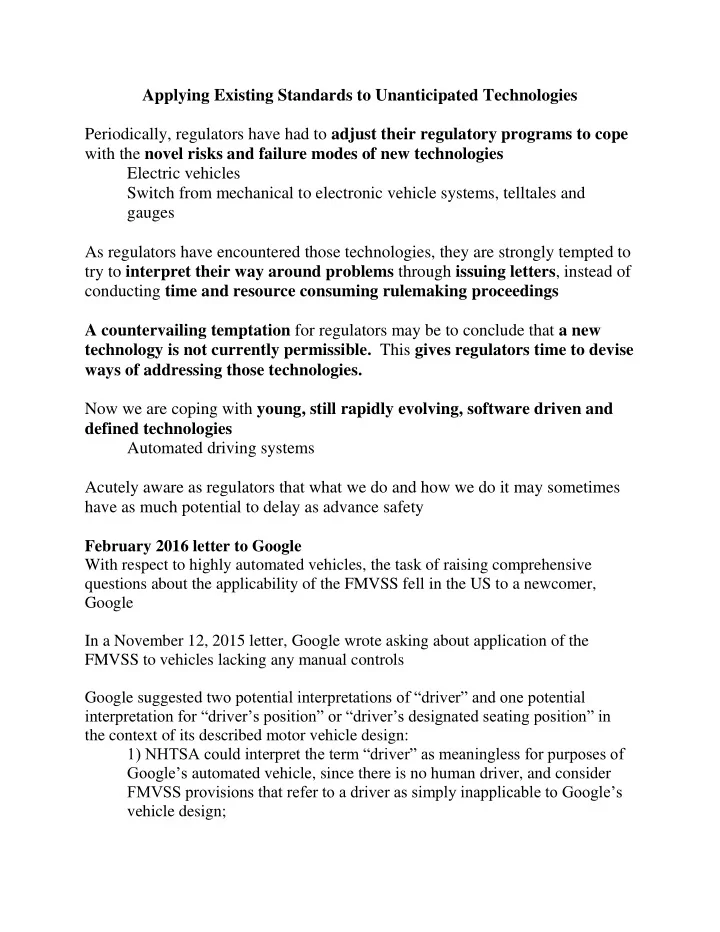

Applying Existing Standards to Unanticipated Technologies Periodically, regulators have had to adjust their regulatory programs to cope with the novel risks and failure modes of new technologies Electric vehicles Switch from mechanical to electronic vehicle systems, telltales and gauges As regulators have encountered those technologies, they are strongly tempted to try to interpret their way around problems through issuing letters , instead of conducting time and resource consuming rulemaking proceedings A countervailing temptation for regulators may be to conclude that a new technology is not currently permissible. This gives regulators time to devise ways of addressing those technologies. Now we are coping with young, still rapidly evolving, software driven and defined technologies Automated driving systems Acutely aware as regulators that what we do and how we do it may sometimes have as much potential to delay as advance safety February 2016 letter to Google With respect to highly automated vehicles, the task of raising comprehensive questions about the applicability of the FMVSS fell in the US to a newcomer, Google In a November 12, 2015 letter, Google wrote asking about application of the FMVSS to vehicles lacking any manual controls Google suggested two potential interpretations of “driver” and one potential interpretation for “driver’s position” or “driver’s designated seating position” in the context of its described motor vehicle design: 1) NHTSA could interpret the term “driver” as meaningless for purposes of Google’s automated vehicle, since there is no human driver, and consider FMVSS provisions that refer to a driver as simply inapplicable to Google’s vehicle design;
2) NHTSA could in terpret “driver” and “operator” as referring to the automated driving system; or 3) NHTSA could interpret “driver’s position” or “driver’s designated seating position” as referring to the left front outboard seating position, regardless of whether the oc cupant of that position is able to control the vehicle’s operation or movements. NHTSA generally agreed with the thought behind the first Google suggestion, but adopted the second suggestion — interpreting driver as referring to the automated driving system Noted that in a number of important instances, rulemaking would be necessary to develop ways of testing highly automated vehicles that cannot be driven by a human driver March 2016 report by the Department of Transportation’s Volpe National Transportation Systems Center on the results of its scans for obstacles in FMVSS The center ’s mission --anticipating and addressing issues regarding emerging technologies across all modes. Volpe conducted two reviews of the FMVSS : a driver reference scan to identify which standards include an explicit or implicit reference to a human driver The driver reference scan revealed references in numerous standards to a driver (defined in §571.3 as “…the occupant of the motor vehicle seated immediately behind the steering control system”), a driver’s seating position, or controls and displays that must be visible to or operable by a driver, or actuated by a driver’s hands or feet. an automated vehicle concepts scan to identify which standards could pose a challenge for a wide range of automated vehicle capabilities and concepts. In order to conduct the automated vehicle concepts scan, the Volpe team developed 13 different automated vehicle concepts, ranging from limited levels of automation (and near-term applications) to highly automated, driverless concepts with innovative vehicle interior designs.
In summary, the review revealed that there are few barriers for automated vehicles to comply with FMVSS, as long as the vehicle does not significantly diverge from a conventional vehicle design. However, automated vehicles that begin to push the boundaries of conventional design (e.g., alternative cabin layouts, omission of manual controls) would be constrained by the current FMVSS or may not fully meet the objectives of the FMVSS. Many standards, as currently written, are based on assumptions of conventional vehicle designs and thus pose challenges for certain design concepts, particularly for ‘driverless’ concepts where human occupants have no way of driving the vehicle. Obstacles to modifying or eliminating features that may have been obsoleted by automating the driving task What did the human driver need that the automated driving system will not need? For example, which telltales and mirrors will be needed by occupants of highly automated vehicles? How does the answer to that question change if there is an emergency stop button in the console between the two front seats? Can we answer these questions through a simple interpretation or is some sort of public process necessary to obtain input from the industry and public alike? If interpretations will not solve all problems, what can regulators do? Exemptions Given the difficulty of demonstrating and quantifying the level of safety, how are regulators to convince the public that they can determine whether an automated vehicle actually offers a level of safety equivalent to that of a non-automated vehicle? Rulemaking
Opens the door not only to remove obstacles in existing standards, but also to consider whether it is necessary to take steps to ensure that the automated safety performed safely.
Recommend
More recommend